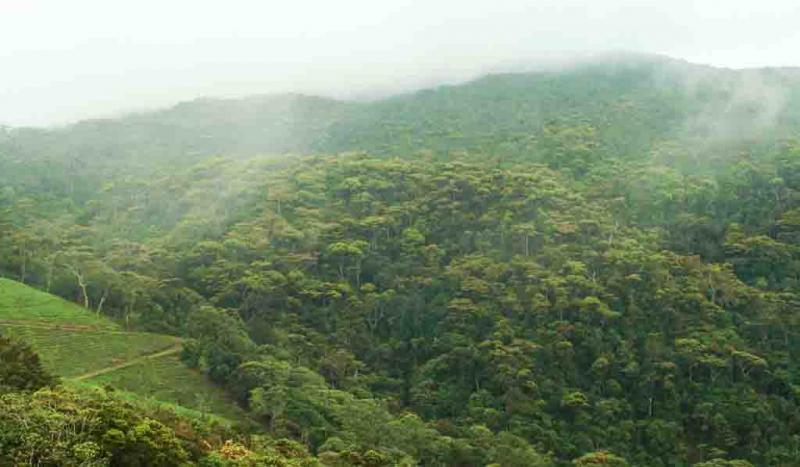Tropical montane forest
The tropical montane forests of Sri Lanka occur above 1500 m in the Central Highlands and Knuckles mountains, but their best development can be seen above 1800 m, and crown the highest mountains and plateaus of Sri Lanka. There is a marked difference in floristic composition and physiognomy against the sub montane forests of middle elevation. They are also known as cloud forests. The largest single expanse occurs as a crescent extending from Siripada to Pidurutalagala (across the Nuwara, Eliya and Horton plains). Pidurutalagala is the highest peak on the island measuring 2524 m and this is still below the timberline for these forests, and there is no upper conifer zone. Isolated patches can also be found on Knuckles, Namunukula and Haputale.

Tropical montane forest in Loolecondera
The hot air of the lowlands rise during the morning hours and condense creating huge clouds, which become so heavy that they result in afternoon rains. They cover a total of 1.1% of our land area. At lower elevations, the cloud forests give way to a variety of vegetation, consisting of both temperate and tropical plants, and grassland savannas. Floristically they are less rich than the forests of lower altitudes, but about 50% of all their species are endemic to Sri Lanka. Their structure is also less complex with all trees more or less arranged in a single layer. Their canopies normally reach heights of about 30 feet but on rare occasions extreme dwarf varieties of these jungles occur reaching no higher than about 3 feet. These so-called pygmy rain forests can be found, for example, on Knuckles Wilderness. Another unusual feature is the lack of conifers and members of the Fagaceae, which normally play an important role in the montane forests of Southeast Asia. Conifers, in particular, often form important emergents, but on Sri Lanka this role is mainly played by endemic species of Calophyllum (Hypericaceae). The frequency of various species of Symplocos (Symplocaceae) is a further peculiarity with all but one of them endemic. The tree layer typically comprises Acronychia pedunculata, Actinodaphne ambigua, Adinandra lasiopetala, Aporosa latifolia, Elaeocarpus montanus, Euonymus rovolutus, Gordonia zeylanica, Litsea ovalifolia, Michelia nilagirica, Microtropis ramiflora, Neolitsea fuscata, Olea polygama, Photinia notoniana, Plectronia montana, Pygeum wightianum, Rhamnus arnottianus, Scolopia crenata, Syzygium revolutum, Symplocos spicata and Terstroemia japonica.
While among the many endemic species are Calophyllum walkeri (Hypericaceae), Cinnamomum litsaefolism, Litsea iteodaphne (Lauraceae), Syzygium rotundifolium and S. umbrosum (Myrtaceae). Epyphytes continue to be a major element with many orchids such as Cirrhopetalum odoratissima, Coelogyne odoratissima, Dendrobium aureum, Eria bicolor, Oberonia wightiana and the endemic Ipsea speciosa (Orchidaceae) covering the branches of trees. Mosses and filmy ferns cover many of the tree trunks and lichens hang from twigs. However, there are fewer climbers, but species such as Asparagus falcatus, Elaeagnus latifolia and Toddalia asiatica are often prominent. On the Knuckles range there are a number of rare, endemic species associated with these forests such as Calophyllum trapezifolium (Hypericaceae), Eugenia lucida, E. phylliroides (Myrtaceae) and Stemonoporus affinis (Dipterocarpaceae) that are confined to these mountains. In general the field layer is often densely carpeted with Webera montana, species of Stenosiphonium and dwarf bamboos such as Indocalamus wightianus, Oxytenanthera monodelpha and Teinstachyum attenuatum. Other associated species include Diacalpe aspidioides, Doodia dives Lastraea beddomii, Leptgramme totta, Lomaria patersoni, Muranta fraxinae and Osmunda javonica.
These forests provide an ideal habitat for many animals including many mammals Leopard (Panthers pardus), Wild Boar (Sus scorfa), Barking Deer (Muntiacus muntjak), Loris (Loris tardigardus) the smaller cats, the Purple faced Leaf Monkey, Porcupine (Hystrix indica) and Golden Palm Civet (Paradoxurus zeylonensis). New species of frogs, lizards, fish and crabs are still being discovered here. One of the smallest terrestrial mammals in Sri Lanka, Kelaart’s Long-clawed Shrew (Feroculus feroculus), is found only in the mountains of this eco region while the endemic Pigmy Lizard (Cophotis ceylanica) is found only in cloud and montane forests above 1300 m.
Elephants once roamed in Sri Lanka’s Cloud forests, where they formed tunnel-shaped paths through the undergrowth of mainly Strobilanthes spp. (Sinhala – Nillu). Only a few are left now on the Rakwana side of this forest.
These high altitude forests are the source of almost all Sri Lanka’s major rivers. The protection of these forests, which are catchments, will ensure that the rivers have water right throughout the year especially during the dry weather. A catchment is where the rainwater is absorbed into the soil and released steadily throughout the year.

